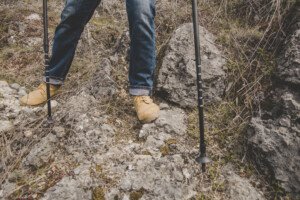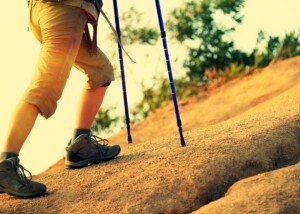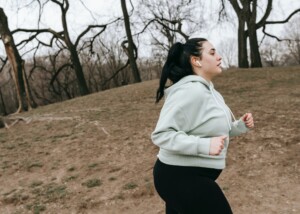
Have you been told you’re too big to take up trail running? Or perhaps you “feel” too heavy to go on your first trail run?
There’s something uniquely magical about trail running. But it also has a built-in challenge: It’s not easy.
Even a thin person could get wiped out pretty quickly sustaining a trot up a steady incline outdoors.
However, if you’re on the thick side or even 50 pounds overweight, don’t let this stop you from moving beyond a hiker’s pace next time you’re on a scenic trail.
Trotting uphill is actually a lot gentler on the knees than trotting downhill.
I once knew a slender man who had no problem jogging up trails, but had to walk down them due to knee problems.
Certainly, if your knees hurt when performing a particular activity, you should avoid that activity and find out from a physician why your knees hurt and how to correct this problem.
But if your knees feel fine when jogging, including uphill, then there’s no reason why you shouldn’t engage in this activity. It’s about listening to your body.
How to Get Started with Trail Running if You’re Overweight
Many people think in terms of long-duration running. Thus, if they can’t run for longer than 30 seconds while seeing other people continue up that long trail without a hitch, they feel defeated.
“Don’t try to run before you can walk!” says Dr. David Beatty, MD, a retired general practitioner with 30+ years of experience and an instructor of general medicine for 20+ years.
“If you don’t usually walk more than a couple of hundred yards, don’t expect to do a six mile trail run straight away.
“You need to gradually increase your walking distance. As this becomes easier, step up your walking speed.
“After that do some short spells of jogging so that you alternate walking and jogging. As your fitness level improves, increase the jog to walk ratio.”
Thus, if all you can do is trot for 30 seconds at a time, then that’s what you should do. Trot, walk, trot, walk, trot, walk.
Over time, with consistency, the trots will become longer and the walks in between will be shorter.
You need to build endurance, which can take time.
Another important factor is that of not overdoing things. If you run too fast, you can become very fatigued after only 15 seconds. Slow down. There’s nothing wrong with a very slow jog.
But if your slowest jog still leaves you exhausted after half a minute, then again, simply alternate these brief slow jogs with walking, during which your body will recharge.
“I’d advise that you start your exercise regime in a park or playing field,” says Dr. Beatty.
“Do short distance circuits. That way if you feel shattered you aren’t too far away from your home or car.
“You don’t want to collapse three miles from home in an isolated country area.
“You’re less likely to get impact injuries if you run on a soft surface such as grass or a dirt track. Paved roads are harsher on the legs.”
You’ll also want to start out on slight inclines. Higher-grade trails can burn out your calves quickly and also get you quite winded quickly.
Also, don’t get caught up with noticing that other people on the trail are blitzing past you.
They, too, once had their starting point. And for all you know, they’ve been trail running for years, several times a week.
Other Preparations
“Get good quality comfortable running shoes,” says Dr. Beatty.
“They need well-cushioned soles to act as a shock absorber. This will reduce the chance of you getting impact injuries such as plantar fasciitis, shin splints, and ankle, knee or back injuries.
“These may be expensive but they’re worth it. Also get a sports bra that you’re comfortable with.
“A lightweight backpack is useful for a drink, a phone, emergency rations and spare laces.”
Hiking Poles

Freepik.com
Be very judicious when using these, as you don’t want to become overly reliant upon them.
Think of walking sticks or poles as a launching pad or transitory phase to fully independent trail use.
“If the downhill stretches are causing problems then consider walking these parts,” says Dr Beatty.
“Nordic poles are particularly useful when walking downhill — they give you two more points of contact with the ground, so they help you balance and they also distribute your weight so that the arms take some of the strain.
“They collapse down easily and can be attached to a backpack when you don’t need to use them.
“Lots of serious hikers use them to take the strain off the knees and back.”
Nevertheless, you’ll want to also try to avoid trails for which there’s no choice but to use a precarious downhill path — until your joints become strong enough to confidently handle this challenge without relying a lot on hiking poles.
What Won’t Help with Your Trail Running
If you think that holding onto a treadmill while jogging at an incline will make you more efficient at trail running – THINK AGAIN.
You absolutely want to avoid this big mistake. When you’re outdoors, you’re not holding onto anything.
Therefore, why would holding onto a treadmill be effective at training your body to jog up a hill?
Holding on completely alters gait and creates an artificial environment.
This is why you can hold on till the cows come home for months on end, but then when you go outside for your first trail run of the season, you conk out within 30 seconds.
Holding onto a treadmill subtracts workload from your entire legs and also low back. When you trot up a trail, your lower legs and core are thoroughly engaged.
If jogging an incline on a treadmill without holding on is too difficult, this means you need to set a slower speed and/or lower the incline.
You need to find the settings that you can actually use without cheating by holding on.
However, even if you don’t hold on when using a treadmill incline, this won’t fully prepare you to run up grades outdoors.
It will help a little, but ultimately, by far, the best way to train for trail running is to actually go trail running.
Go slowly. Choose a mild grade. See if you can sustain it for 30 seconds. If so, go for a minute.
Go for as long as you can, then do some walking to recharge, then resume the jogging.
Make It Fun
A fun way to become more efficient at running on trails is to choose a stretch of trail that’s rather flat, but has occasional short steep grades.
Every time you get to one of these grades, burst up it. Even if the burst lasts only five seconds, enough of these will have a training effect.
This approach is particularly appealing because you get to go relatively fast, due to the shortness of the inclined area.
Trail Running if You’re Overweight
The aforementioned training approaches apply to people of all sizes.
If you’re overweight and can hike reasonably decently, there’s no reason why you can’t begin inserting some trotting intervals into your hikes.
Unless you’re morbidly obese (at least a hundred pounds overweight), don’t become obsessed with losing weight first before trying a little trail running – unless your knees or feet hurt when attempting it.
Otherwise, with ample hydration, comfortable clothes and footwear designed for running, you’re ready to start enjoying some trail running!
 Dr. Beatty has worked in primary medicine, surgery, accident and emergency, OBGYN, pediatrics and chronic disease management. He is the Doctor of Medicine for Strong Home Gym.
Dr. Beatty has worked in primary medicine, surgery, accident and emergency, OBGYN, pediatrics and chronic disease management. He is the Doctor of Medicine for Strong Home Gym.
 Lorra Garrick is a former personal trainer certified by the American Council on Exercise. At Bally Total Fitness she trained clients of all ages for fat loss, muscle building, fitness and improved health.
Lorra Garrick is a former personal trainer certified by the American Council on Exercise. At Bally Total Fitness she trained clients of all ages for fat loss, muscle building, fitness and improved health.
.









































